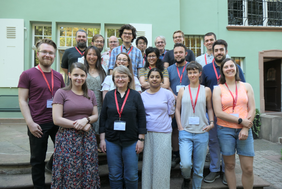Connected by the common goal to uncover the origin of our elements, Dr. Andreas Sander from the Astronomisches Rechen-Institut (ARI) of the Center for Astronomy of Heidelberg University (ZAH) hosted his "Hengstberger Symposium" on nucleosynthesis and stellar yields of massive stars at the Internationales Wissenschaftsforum Heidelberg (IWH) from September 4th to 8th 2023.
Supported by the prize money from his prestigious "Hengstberger prize", which Andreas Sander was awarded in 2022, the symposium brought together 25 researchers from around the globe for a five-day in-depth discussion workshop. Ranging beyond traditional astrophysical borders, the symposium included researches from a diverse range of fields, covering not only stellar winds, structure, and evolution, but also supernova and neutron-star merger modelling, nuclear astrophysics, as well as geochemistry, underlining the incredible interconnections of massive stars in the origin of our elements.
Unlike many conferences where speakers mainly present their research in a sequence of talks with very limited time for questions and dicussions, this invite-only symposium encouraged attendees to engage in open dialogues immediately during the talks. "Ahead of the symposium, I was not sure whether this concept would work out", said Andreas Sander, "but already during the first talk the ice was broken." Martyna Chruslinska, postdoctoral research fellow at MPA Garching, started the week with a big picture introduction on the chemical evolution of galaxies. One detail she outlined was the different terminology used in different astrophysical communities, for example when using the term "metallicity". "Discussing such differences immediately when they occur is crucial to fully comprehend the results derived in a different field and make it applicable for your own research efforts" Andreas Sander added.
One major challenge in uncovering the origin of our elements is the need to efficently map complex physical processes in larger-scale models. Realistic multi-dimensional models such as for example presented by Susanne Höfner (Uppsala University, Sweden) for cool giant stars, William Raphael Hix (Oak Ridge National Laboratory, USA) for core-collapse supernovae, or Andreas Bauswein (GSI, Darmstadt) for neutron-star mergers often require many months of computing time, but are essential to really understand all of the involved physical processes. On the other hand, chemical evolution models for galactic or even cosmological scales need to connect many different orders of magnitude. "For this to be feasible, we need to strongly parameterize the results from the individual stellar scale", explains Prof. Chiaki Kobayashi from the University of Hertfordshire.
A rather unconventional presence at astronomical gatherings were the invited geoscientists, such as Prof. Mario Trieloff from the Institute of Earth Sciences here at Heidelberg University. But the fields are linked closer than one might expect. We can gain astrophysical insights from meteorites hitting our Earth, for example on the types of dust grains that must have formed in the vicinity of evolved stars. Vice versa, it requires astrophysical simulations to identify the origin of life-creating elements such as oxygen or phosphorous. The topics are also connected by specific radioactive nucleids that are produced in massive stars and play a crucial role in heating planetesimals like the proto-Earth in the early solar system. Beside Prof. Trieloff and the group of Dr. Sander, local participants from Heidelberg also incuded Dr. Eva Laplace and PhD student Vincent Bronner from the HITS as well as Dr. Genevieve Parmetier from ARI and the oncoming new ZAH Gliese Fellow Dr. Tadafumi Matsuno.
The symposium was accompanied by an optional excursion through Heidelberg's old city and its astronomical connections, including a visit to the Great Hall of the Old University. "All of us learned a lot this week and several participants mentioned how much more connections of their research they discovered this week", concluded Andreas Sander after the very inspiring symposium. In the spirit of collaboration and knowledge exchange, the attendees are now planning to write an overview paper. This paper will serve as a bridge between traditionally separated communities, synthesizing the insights gained during the symposium and outlining the research imperatives for each field. By doing so, the team hopes to chart a path forward that will guide future scientific investigations and foster interdisciplinary collaboration.
RELATED LINKS
Hengstberger-Symposium Website: https://wwwstaff.ari.uni-heidelberg.de/ansander/workshops/stellar-yields
Research Group Webseite: https://wwwstaff.ari.uni-heidelberg.de/ansander/
International Academic Forum Heidelberg: https://www.uni-heidelberg.de/einrichtungen/iwh/index_engl.html
Hengstberger-Preis: https://www.uni-heidelberg.de/einrichtungen/iwh/hengstberger/

